|
|
| |
| 1931
Bentley 8 Litre |
|
|
Original 1931 Numbers
Chassis
No. YR5088
Engine No. YR5088
Registration No. SM 8794
|
|
This car - updated
Chassis No. YR5088
Engine No. -
Registration No. -
(Current owner / former owners, please come forward with further updates. - September 2018) |
|
| |
|
|
 |
| 2014 |
| Click
on thumbnail for larger view |
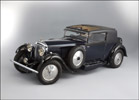 |
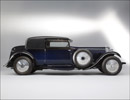 |
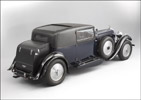 |
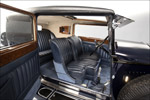 |
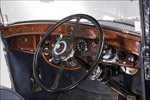 |
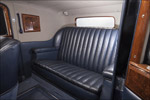 |
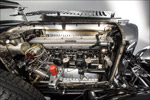 |
|
|
|
| |
 |
| |
Lot No. 380
Retromobile by Artcurial Motorcars | Paris, 07 February
1931 Bentley 8 Litre
Coupe Sportsman by Gurney-Nutting
Summary
Chassis No. YR5088
Interior colour: Blue
Number of doors: 2
Number of seats: 2
Drive: RHD
Location: France
Gearbox: Manual
Drivetrain: 2wd
Fuel type: Petrol
Description
Chassis No: YR5088
Estimate: EUR 2 500 000 - 3 000 000
- Exceptional in every way
- Continuous history
- The last " big " Bentley
- Aesthetic masterpiece
- Impeccable presentation
- Best Coachwork Award in 1932 at the RAC Rally - Best of Show at the Louis Vuitton Concours in 1999 - Extensive number of Awards at Bentley's meetings
With victories to its name in the Le Mans 24 Hours, Bentley had definitely proved itself in competition. To knock Rolls-Royce off the top spot for British luxury automobiles however, it was necessary to go one step further. And so, at the 1930 London Motor Show, the marque presented the 8-Litre. Employing the engineering of the imposing 6.5-litre, this car called for all the superlatives. The in-line six-cylinder engine had a single overhead camshaft and four valves per cylinder and with 7,983cc, it produced 220 bhp at 3,500 rpm. In other words, it was exceptionally versatile and was reported as such in period road tests, such as The Autocar of 1930 : " While offering the performance of a sports car (....), this car can be driven in top gear, as slowly as a man walks, and can accelerate without snatch and without difficulty. " Right through to a top speed of 160 km/h ! This was a higher number than Rolls-Royces were capable of, even though the 8-litre chassis was longer than the longest comparable Rolls-Royce. However, despite these indisputable qualities, and along with many of its rivals, the Bentley 8-Litre suffered from the Great Depression that followed the 1929 Crash and just 100 examples were built, making it a particularly rare model. Naturally, a technical masterpiece such as this attracted the most reputable coachbuilders, who exercised all their talent on creating bodies for the car. It was Gurney-Nutting, one of Bentley's most trusted coachbuilders along with Vanden Plas, who was responsible for the Sportsman coupé, a marvel of design with perfect balance for a chassis of this size. Its beauty was recognised immediately, and the car won the 1932 " Best Coachwork " Trophy at the RAC Rally.
At this time, our 8-Litre was in the hands of its first owner, an extraordinary character, by the name of Captain John Moller. Moller was a pilot and a photo taken at the 1932 RAC Rally, shows the car displaying the mascot of a Gipsy Moth that was associated with him. In a letter from 1999, Lord Monro of Langholm recalls having been present when the new car was delivered, and notes that his sister appears in one of the black and white photos that come with the car. He also indicated that it was in this 8-Litre car that he first drove at 180 km/h, and that when John Moller parted with his car, he sold it to Sir Edmund Findlay, a newspaper proprietor from Scotland. The maintenance documents show that in 1938 the car was regularly driven and maintained. In 1955 it was registered in the name of D.A. Dale and a document from 1964 shows that it had been taken off the road for some time while retaining its original registration, SM 8794. The subsequent owner was Mr John A MacQueen of Deansfield House, Stafford, and it was him who sold the car to Charles Teall during the 1970s. This splendid Gurney-Nutting coupé still had all its original components and Teall decided to restore it completely, with breathtaking results. The provenance, quality and condition of this Bentley 8-Litre won it numerous awards : " Best of Show " at the Louis Vuitton Classic at the Hurlingham Club in 1999 and second in class at the 2001 Pebble Beach Concours d'Élégance. It is perhaps more important to note the prizes awarded by Bentley Driver's Club, whose judges share an unrivalled knowledge of this type of car : in 1937 " Best Vintage Saloon ", then " Best 8-Litre " and more recently, the meeting's " Best Vintage Bentley ". These trophies and awards highlight the recognition given to this important automobile, which is not surprising: the Gurney-Nutting coachwork has a rare beauty and succeeds in giving this substantial chassis a light, sporting appearance. The relatively short wings, the streamlined running boards that double up as storage space, the covered wheel hubcaps, the narrow and discreet bumpers and the roomy trunk shaped to fit in with the rear styling all come together to give a dynamic and balanced whole. At the front, the high chrome radiator grille, surmounted by a mascot of a winged female torso, and framed by three headlamps, is a perfect representation of this type of model.
Superlatives abound for the interior as well, with the doors opening up to a passenger compartment with blue leather seats and door-linings that display a light and flawless patina. The whole interior is inviting and comfortable. The driver's seat has a carefully designed cut away section to allow easy use of the gear and brake levers, and the blue carpet is immaculate. Wood lines the dashboard, door panels and courtesy equipment for the rear passengers, and the roof opens up over the front seats, transforming the drive into a sunny and airy experience. The dashboard displays a selection of superbly presented instruments and the centre of the steering wheel sports the traditional controls for advance, choke and hand throttle.
A glance under the bonnet reveals what this 8-litre Bentley is capable of : its enormous engine fills the available space, in a stunning blend of simplicity and sophistication. The car as a whole is impeccable and if it shows some general signs of wear, this represents normal use and meticulous maintenance.
Previous owners have not hesitated to use this fantastic Bentley 8-Litre on long journeys and it is ready to offer the same pleasure to whoever seizes the opportunity this auction sale provides.
A true aesthetic and technical achievement, a centrepiece of Bentley's history, a testament to the top-level rivalry between the finest marques, this 8-Litre Bentley is far more than an automobile : it is a work of art encapsulating the heritage of the most prestigious automobiles in the world.
|
|
| |
|
|
| |
|
|
| |
Source:
ClassicDriver
Posted: Sep 27, 2018 |
|
| |
|
|
|
|
 |
 |
| April
2009 |
| Click
on thumbnail for larger view |
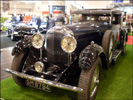 |
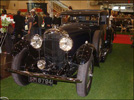 |
|
|
| |
 |
| |
Technoclassica
Essen 2009 |
|
| |
|
|
| |
|
|
| |
Source:
Flickr, posted by users 'jenskramer78'
& 'Lil Frits'
Posted: Apr 04, 2012 |
|
| |
|
|
|
|
 |
 |
| 2008 |
| Click
on thumbnail for larger view |
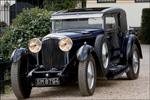 |
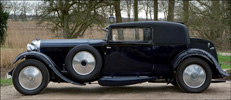 |
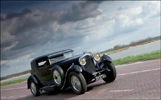 |
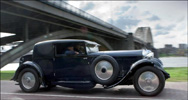 |
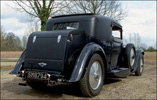 |
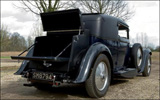 |
|
| |
 |
| |
|
|
| |
|
|
| |
Source:
The Art of Living, BE
Posted: Apr 04, 2012 |
|
| |
|
|
|
|
 |
 |
| 2008 |
| Click
on thumbnail for larger view |
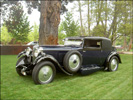 |
|
|
|
| |
 |
| |
The Bentley 8-liter
was shown to the public for the first
time at the London car show on Earl
Court in 1930. With an engine which
had been inferred directly of the
six-one-half liter version of the
race winning Speed Six, the Bentley-factory
entered the competition battle with
Rolls Royce. At the Rolls Royce factory
were `not amused’ that this new
Bentley was able to do a top of 100
miles per hour, whereas the fastest
Rolls obtained 90 mph with great difficultly.
The complete name of this car is:
Bentley 8-liter Sportsman Coupe. This
version with the relatively short
footing of 144 inch was identical
to those of the Rolls Royce Phantom
but this YR5088 has 156 inches between
the front and rear wheels, which is
a half foot longer than the longest
similar type Rolls.
It also made the Bentley 8-liter considerably
more expensive: the rolling chassis
cost the sum of £ 3,700 British
pound - a really firm price tag for
that time - and after that the bodywork
would cost another £2.000 British
pound. A lot of money for just one
car and the timing of the introduction
was picked extremely bad as the Great
Depression had announced itself. It
cost a fortune just to put this car
on the market and because of the worldwide
financial misery the customers did
not stand in line to buy with perhaps
as exceptions; the Prince of Wales
and the Duke of York !
Woolf Barnato, president and most
important financer of Bentley took
his loss and left, cutting all ties.
After production of just 100 Bentley's
8-liter production was stopped.
To make sure that in the future the
mark Bentley would never be able to
do this ‘trick’ again (and
as such embarrass the mark Rolls Royce)
the Bentley factory was saved from
bankruptcy by Rolls Royce. They (RR)
set-up a complete new line of models
which had to serve as basic models
for the ultra luxuriously segment
in which RR would have the lead. No
new Bentley 8-liter engine would ever
see daylight again if Rolls Royce
could help it!
This Bentley 8 liter Sportsman Coupe
with chassis number YR5088 came out
of the factory in 1931 and became
a supreme Gurney Nutting coachwork,
which an incredibly beautiful and
simply unique coachwork and it came
if no surprise that this sport man
Coupe in 1932, in RAC-rally won the
best Coachwork Award. The British
had rally’s with everything that
had 3 or 4 wheels, even with a mastodont
of a car such as this one. In the
many years to come this car - recording
SM8794 - would win a lot of prices;
like during Louis Vuitton Classic
in 1999. And after a lot of different
owners when it was in the possession
of the first American collectorit
won at Pebble Beach (California) the
2001 a real prestigious price: “Second
in Class”. The current owner
of this jewel has in his possession
of a letter from 1999 of The Right
Honorable Lord Monro Langholm who
was present at the delivery to the
first owner, a certain Captain John
Moller.
These Moller just to fly in a Gipsy
Moth - the famous British plain which
was top-of-the-bill at that time –
which explains why on a photograph
of the car during RAC-rally a badge
of the Gipsy Moth can be seen. For
Lord Monro it was the first time he
would - together with Moller - drive
a car at the powerful speed of 100
miles per hour!
The interior of the Bentley 8-liter
is overwhelming with regards to comfort
and class and the upholstery is still
perfect. The dashboard has been filled
with Bentley instruments.
In the back a chic miniature-bar has
two original crystal whisky glasses
with a carafe on both sides. The Gurney
Nutting original and very large ‘drawer-roof-part’
which was the incorporated in the
roof as well as the woodwork are in
top condition. The outside the Bentley
looks particularly beautiful as the
blue lake is in virtually perfect
state. The car stands high on its
21 inch wheels and the relatively
small track breadth with respect to
altitude makes a striking apparition
of these splendid Bentley.
Driving with the car is a joyful event
in itself. Sound insulation is such
that you must look at the revolution
counter to see if the engine runs.
The eight bearings in the crankshaft
also contribute to a extreme quiet
behavior of the engine. Once on pace
it is no problem to go to the highest
gear because the car has a huge cross-belt.
Maneuvering this car is a different
story all together. The car may have
got the name Sportsman Coupe, driving
it is not at all sporty. It is certain
that it takes enormous muscle balls
just to handle this Bentley on the
road not to mention turning it. The
immense weight ensures that something
as taking a roundabout rapidly simply
becomes impossible. You must put all
your efforts into getting the steering
wheel twisted with two firm hands
and that is an enormous anticlimax,
which proves that the British Upper
indeed gladly displayed themselves
as a sportsman, tough because of the
heavy work a driver was standard with
these cars and the average cricket
or polo player - the sport pre-eminently
where also the British nobility occupied
himself on relaxed Sunday afternoon
– did not have sufficient testosterone
to be piloting this car through the
city of London or Edenbury. Although
it is a very special treat to be able
to get acquainted with this powerful
car which is a beautiful piece of
British heritage. |
|
| |
|
|
| |
|
|
| |
Source:
Auto Art Collection
Posted: Nov 06, 2008 |
|
| |
|
|
|
|
 |
|
|
 |
|
|
 |
 |
| 2006 |
| In
USA in 2006 / Owned by an RROC member |
 |
|
 |
| Click
on thumbnail for larger view |
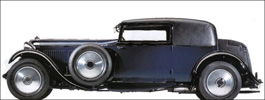 |
|
|
|
| |
 |
| |
|
|
| |
|
|
| |
|
|
| |
Source:
Auto Art Collection
Posted: Nov 06, 2008 |
|
| |
|
|
|
|
 |
| Click
on thumbnail for larger view |
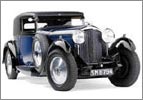 |
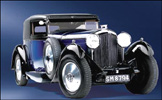 |
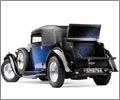 |
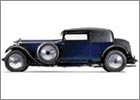 |
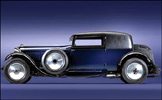 |
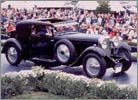 |
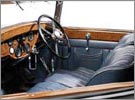 |
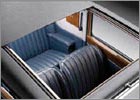 |
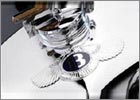 |
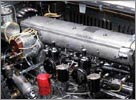 |
 |
 |
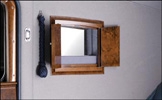 |
|
|
|
| |
 |
| |
The 1999 Louis Vuitton
Classic Best of Show and Multiple
Award Winning
Coachwork by Gurney Nutting
Chassis no. YR 5088
The outstanding 8-Liter Bentley we
have the pleasure of offering here
is a well-known and very rare Fixed
Head Coupe that still retains its
original custom coachwork as fitted
by Gurney Nutting in 1931. It is a
well-documented car with a complete
Bentley Driver’s Club history
file detailing most of the Bentley’s
provenance from new. The stately sunroof
coupe’s first owner was a Mr.
John H. Moller. Mr. Moller was a flying
man by nature, known for his exploits
in a Gipsy Moth, and photos of the
car while in his ownership first show
the Bentley with an aeroplane mascot.
Notably, while under Mr. Moller’s
ownership the Bentley was entered
in the 1932 RAC Rally where it won
the Coachwork Award.
The 8-Liter’s recent history
is highlighted by the ownership of
Mr. Charles Teall who executed an
exhaustive ten-year long restoration
that brought the car back to its resplendent
original condition. Following the
restoration the Bentley was debuted
at numerous BDC events where it was
awarded “Best Vintage Bentley”,
“Best Vintage Saloon” and
“Best Bentley 8-Liter”.
The Sportsman’s Coupe was then
shown at the 1999 Louis Vuitton Classic
at the Hurlingham Club where it earned
the prestigious honors of “Louis
Vuitton Grand Prix Best of Show”.
Twelve years after the Bentley’s
restoration, now under its first U.S.
owner, the car was shown at the Pebble
Beach Concours d’Elegance where
it was awarded a Second in Class.
Since then the Bentley has been expertly
maintained as one of the most mechanically
sound and most pleasant drivers in
the country. It is in excellent overall
condition and still retains the distinction
of having its original engine and
coachwork from new. It is an exceptionally
handsome car that we are delighted
to present at the 2006 Amelia Island
Vintage Motor Car auction. |
|
| |
|
|
| |
|
|
| |
Source:
RM Auctions Inc.
Updated: May 21, 2007
Updated: Apr 21, 2006
Updated: Feb 22, 2006
Updated: Feb 21, 2006
Posted: Feb 20, 2006 |
|
| |
|
|
|
|
 |
|
|
 |
 |
| 2006 |
| Click
on thumbnail for larger view |
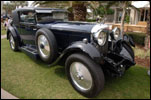 |
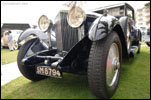 |
 |
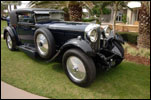 |
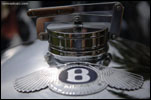 |
 |
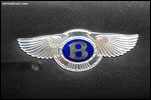 |
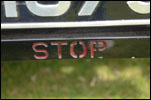 |
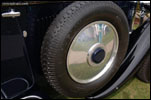 |
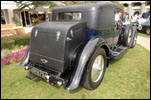 |
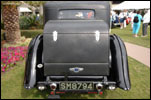 |
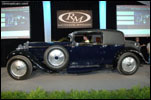 |
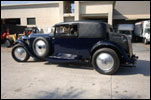 |
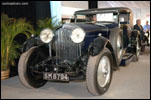 |
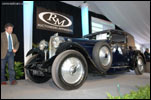 |
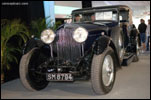 |
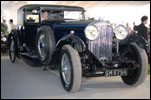 |
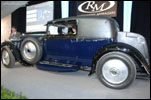 |
 |
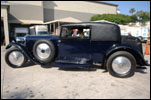 |
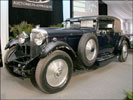 |
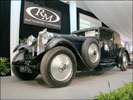 |
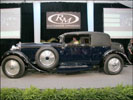 |
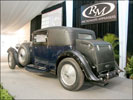 |
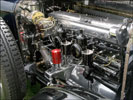 |
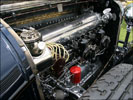 |
|
|
| |
 |
| |
1931 Bentley 8-Litre
Sportsman Coupe Gurney-Nutting
"This 1931 Bentley 8-Liter Sportsman
Coupe has coachwork by J. Gurney-Nutting.
It has won the 1932 RAC Best Coachwork
Award, and the 1999 Best in Show of
the Louis Vuitton Classic at the Hurlingham
Club. In addition, it has won a number
of BDC Awards and a Second in Class
at the Pebble Beach Concours in 2001.
It is powered by a 7983 cc, overhead
camshaft inline six-cylinder engine
with four valves per cylinder, dual
carburetors, and capable of producing
220 horsepower at 3500 rpm. A four-speed
manual gearbox sends power to the
rear wheels while the four-wheel servo
assisted drum brakes provide the stopping
power. It sits atop a 156 inch wheelbase
and suspended in place by semi-elliptic
leaf springs in both the front and
the rear.
The Bentley 8-Liter was first shown
to the public at the 1930 London Motor
Show. It was impressive in design,
stature, and performance. It was capable
of 100 mph, 10 mph faster than the
comparable lightweight Rolls-Royce.
There were two platforms for the 8-Liter
Bentley, a 144-inch and 156-inch wheelbase.
The chassis on the 156-inch version
weight 3700 pounds with the full-bodied
versions tipping the scale at over
two tones! The engineering of the
8-Liter was impressive, with its double-dropped
frame and seven tubular cross members
supporting the mammoth bodies. Aluminum
was used throughout the bodies in
an effort to reduce the weight.
Though the combination of beauty,
power and prestige was enough to make
the Bentley 8-Liter an instant success,
the Great Depression was responsible
for its low production figures, with
only 100 examples being produced.
Feeling the pressure of the Great
Depression and slow sales, Bentley's
chief financier, Woolf Barnato, severed
his ties with Bentley and sending
them spiraling into financial difficulty.
Rolls-Royce intervened, saving the
troubled company from receivership.
They revamped the Bentley model line,
brining their designs and mechanics
inline with the Rolls-Royce family.
The Bentley's now served as the entry-level
cars into the ultra luxury department.
The 8-liters were adorned in stylish
coachwork provided by reputable coachbuilders
such as J. Gurney Nutting and Vanden
Plas. Most of the bodies were graceful
saloons and fixed head coupes.
This example has a blue leather interior.
There is a sliding sunroof and ample
space for luggage in the rear custom
built compartment."
Year: 1931
Make: Bentley
Model: 8-Liter Sportsman Coupe
Gurney-Nutting
Engine Location: Front
Drive Type: Rear Wheel
Body: Material Aluminium
Production Years for Series:
1930 - 1931
Coach Work: Gurney Nutting
Introduced At 1930 London Motor Show |
|
| |
|
|
| |
|
|
| |
Source:
ConceptCarz
Updated: Nov 13, 2006
Posted: May 02, 2006 |
|
| |
|
|
|
|
 |
 |
| May
2006 |
 |
| |
"Polished wheel
discs, dual sidemounts, luggage trunk,
green glass windshield visor, sliding
sunroof, airfoil-shaped running boards.
An excellent old restoration that
took a 2nd in class at Pebble Beach
when it was ten years old. Great paint,
interior and chrome with a nice patina
that only adds to its charm and appeal.
Lovely sweeping fenders. Excellent
interior wood. This car isn't fresh
but it is even better, a sharp, clean
well maintained automobile of impeccable
history. Original engine, body and
chassis. Sold for $442,500 by Christie's
at Pebble Beach in 1999, maybe one
of the best buys of the last decade.
Its style, grace, accoutrements, restoration
and performance lit fires here in
Amelia and brought a huge price, but
also bought a superb Bentley."
|
|
| |
|
|
| |
|
|
| |
Source:
"Victory Lane" magazine, May
2006
Posted: Sep 18, 2006 |
|
| |
|
|
|
|
 |
 |
| 1999 |
| Click
on thumbnail for larger view |
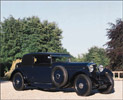 |
|
|
|
| |
 |
| |
LOT 37
29 August 1999
Los Angeles
1931 Bentley 8 Litre Fixed-Head Coupe
Coachwork by Gurney Nutting of London
Chassis No. YR5088
Engine No. YR5088
Price: USD 442,500
Admiralty blue over black with black Everflex top and blue leather interior
Engine: six cylinder in-line, 4 valves per cylinder, 7983cc giving c220bhp at 3500rpm; Gearbox: four speed manual; Suspension: semi-elliptic springs front and rear, Bentley & Draper friction front, hydraulic rear shock absorbers; Brakes: four wheel drum, servo- assisted. Right hand drive.
Introduced to the public at the 1930 London Motor Show, the 8 Litre was the biggest-engined car made in Britain. It was also just about the fastest, fully capable of 100mph with closed coachwork; a legacy of its racing heritage, five wins in that toughest of endurance races, the Twenty-Four Hours du Mans. W. O. Bentley himself said 'I have wanted to produce a dead silent 100mph car, and now I think we have done it.'
The 8 Litre represents an evolutionary step in Bentley's thinking, taking the best features of the legendary Speed Six and adding to them the benefits of engineering advances. The 8 Litre engine bore was increased from 100mm to 110mm, to increase the capacity by 1400cc and to add 40bhp, giving steam turbine-like performance. A new, immensely rigid and much quieter gearbox was designed with dog-clutch engagement on 3rd and top, with a hypoid-bevel back axle. The chassis frame itself was double-dropped front and back to give the coachbuilders a low, rigid platform for formal coachwork. The deep channel pressed steel siderails are joined by no less than one pressed steel and seven tubular steel cross-members. The suspension was redesigned with the springs outside the chassis to increase stability, fitted with Bentley & Draper friction front and hydraulic rear shock absorbers. The steering was stiffened up and a host of detail improvements were incorporated, reflecting Bentley's experience with the Speed Six on and off the race-track.
The Autocar described the 8 Litre as 'Motoring in its very highest form', clocking W. O. Bentley's own 8 Litre saloon at 101.12mph over the 1/2 mile, fully laden. An exhaustive survey of The Autocar's test reports between 1930 and 1939 shows only one faster car - an 8C 2300 Alfa Romeo at 106.8mph. The 8 Litre remained the fastest production Bentley until 1953.
Only 100 of the magnificent machines were built in 1930/31; YR5088 is the 38th. The chassis was completed in January 1931, and despatched to Gurney Nutting to be bodied. Gurney Nutting were one of the very best of the London coachbuilding firms, and the fixed-head coupe body they built on this chassis represents the epitome of the coachbuilder's art. The body is a full four-seater with two large doors and semi-integral trunk, fitted with float-type running boards (after the style of Malcolm Campbell's 'Bluebird'). Gurney Nutting's trademark helmet wings lend lightness and elegance to the design. The interior is spacious, the driver and passenger seats giving a commanding view down the bonnet, the rear seats offering comfort and generous leg room.
Built for a wealthy Scotsman, John Moller, YR5088 was delivered in April 1931 via Rossleighs, Bentley's main Scottish dealer. The registration number SM 8794 was issued by Dumfries CC, the number still in use today. Moller entered YR5088 for the first RAC Rally in March 1932, a reliability trial that required entrants to cover 1000 miles at an average speed of 25mph, converging on Torquay from different start points around the UK. Starting from Edinburgh, Moller finished 92nd out of 232 in the over 1100cc class; doubtless keeping the Bentley down to an average of 25mph proved too much of a chore. Moller also entered the coachwork competition in Class 4b, occasional four-seaters and two-door sports saloons over 1100cc. The Bentley Service Records rather curtly note that the car was entered 'without permission' and cancelled the Five-Year Guarantee shortly afterwards.
In 1935, Moller sold the car to Sir Edmund Findlay, Bt, the proprietor of The Scotsman newspaper. The Bentley saw war service, registered to the Home Office in 1941, including use by the National Fire Service in Sunningdale to tow a trailer fire pump - the fastest fire engine in the south-east. The Bentley then went through a number of owners between 1946 and 1957, when she was bought by J.A. MacQueen. Fortunately the car escaped the fate of a number of 8 Litre Bentleys, of being cut down and used for club racing. YR5088 went into a gentle decline, a decline that proved to be largely benign. When bought by the present owner in 1977 from noted Rolls-Royce expert Barrie Price, on inspection the Bentley proved to be in remarkably original condition.
The 8 litre was then meticulously restored over a period of ten years, with detailed attention not just to the cosmetics, but also to the mechanics. The body has been reskinned and repainted and the wood framing fully restored. The original dashboard is fitted with all the original instruments. The dashboard itself is of burr walnut with walnut cross-banding, a style carried over into the door panels and vanity cases. The original seats and interior fittings were preserved, superbly reupholstered in Connolly hide, with a generous map pocket on each door. The interior is exquisitely detailed, with beautiful small ivory handles on each door-catch, carefully made silk hand-holds and elegant vanity cases set into the rear quarters. Each burr walnut double door opens to reveal an illuminated mirror. One contains a few extra items, such as a lady's powder compact. The rear armrests both lift up, one housing a pair of small cut-glass decanters and tumblers. For complete privacy while powdering your nose or taking a quick nip - a mechanism above the driver's door operates a blind for the rear window.
The roof, fitted with a Pytchley sunroof, was recovered in Everflex, and the boot was similarly treated. With an eye to practical, long-distance use, with a family, the owner decided to adapt the original trunk layout. The original, with a rather impractical opening not much bigger that a letter-box, was restyled, using the trunk on W.O. Bentley's own 8 Litre saloon as a pattern. The addition of six over-centre catches, two with concealed locks, gives a final high-quality touch. The float-type running boards have also been fully restored and painstakingly fitted with pull-out tool trays, each item nestling in its own bed of burgundy baize, an almost complete set of original tools in the left hand box, the jack and greaser in the right hand box. With the Bentley come an original 8 Litre handbook and a boxed 1932 RAC Rally plaque.
On the engineering side, the engine was completly rebuilt with a new crankshaft and set of connecting rods made by that master craftsman, Roger Cook, using shell bearings. A new crankcase and sump have been fitted. Bentley Motors, at the forefront of innovation, started using magnesium alloy (Elektron) early in 1930, using this material for most of the engine castings. Unfortunately the early pattern Elektron crankcase used in the first 49 eight litre engines proved too weak, tending to crack near the front of the castings. New aluminum castings were first commissioned by Stanley Sedgwick some thirty years ago, and many owners have prudently incorporated these into their engines. YR5088 has such a new crankcase and sump; the original Elektron items are present with the car. The crankshaft is fitted with the desirable late-pattern damper.
The top end of the engine has also been fully rebuilt, with a new Phoenix camshaft and needle-roller bearing rockers. All the original electrical equipment has been rebuilt, as well as the brakes, steering, and all the chassis fittings. At present the Bentley is fitted with non-standard rear shock absorbers, but a pair of Bentley & Draper hydraulic units are being rebuilt ready to fit.
The reward for this painstaking and thorough work was first in Classes C and I and the award for 'Best Vintage Bentley' at the Bentley Drivers' Club's Kensington Gardens Concours in 1987. Since then YR5088 has been carefully used and serviced, and recently carried home all of the top prizes at the Louis Vuitton Grand Prix at London's Hurlingham Club which included winning its class, the Ashe Park Trophy for pre-war closed cars and the much-coveted 'Best of Show' award. At the Bentley Drivers' Club Annual Concours at Charlecote Park also this June, the Bentley proved its class again, taking the Best of Show award. YR5088 is undoubtedly one of the most handsome of the surviving 8 Litre Bentleys, and represents a rare opportunity to buy an original car in exceptional order, both mechanically and cosmetically. |
|
| |
|
|
| |
|
|
| |
Source:
Christies
Posted: Sep 27, 2018 |
|
| |
|
|
|
|
 |
|
|
 |
|
|
 |
| Click
on thumbnail for larger view |
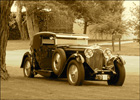 |
|
|
|
| |
 |
| |
|
|
| |
|
|
| |
|
|
| |
Source:
Auto Art Collection
Posted: Nov 06, 2008 |
|
| |
|
|
|
|
 |
| Click
on thumbnail for larger view |
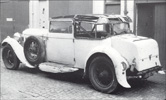 |
|
|
|
| |
 |
| |
Gurney Nutting fixed-head
coupe on Chassis No. YR5088, registration
SM 8794, subsequently beautifully
restored by Charles Teall Esq. |
|
| |
|
|
| |
|
|
| |
Source:
Auto Art Collection
Posted: Nov 06, 2008 |
|
| |
|
|
|
|
 |
| Click
on thumbnail for larger view |
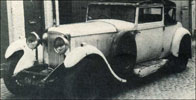 |
|
|
|
| |
 |
| |
This photograph is
from an advertisement by Coys of Kensington
in "Thoroughbred & Classic
Cars" magazine, July 1977.
Text in ad says: 1930 Bentley 8 litre
2-door FHC by Gurney Nutting. Extremely
rare. |
|
| |
|
|
| |
|
|
| |
Source:
"Thoroughbred & Classic Cars"
magazine, July 1977
Posted: Jul 22, 2008 |
|
| |
|
|
|
|
 |
|
|
|
|
 |
| EARLIEST
RECORD OF HISTORICAL FACTS & INFORMATION |
 |
 |
| |
| Chassis No. |
YR5088 |
| Engine No. |
YR5088 |
| Registration
No. |
SM 8794 |
| Date of Delivery: |
Apr 1931 |
| Type of Body: |
Saloon |
| Coachbuilder: |
Gurney Nutting |
| Type of Car: |
13  |
| |
|
| First Owner: |
MOLLER J H |
|
|
| |
|
|
| |
More Info:
Michael Hay, in his book Bentley:
The Vintage Years, 1997, states:
"F/8039. Entered in 1932 RAC Rally.
Used by NFS to tow fire pump in Sunningdale.
Rebuilt with original body still fitted." |
|
| |
|
|
| |
|
|
| |
Posted: Mar 01, 2007 |
|
| |
|
|
|
|
| |
| |
| |
| Submit
more information on this car |
| |
| |
| |
|
|
| |
| |
| |
 |
| |
| |
|
| |
|
 |
 |
 |
Sep 30, 2020 - Info and photograph received from Simon Hunt for Chassis No. RL3439 |
 |
 |
Sep 30, 2020 - Info and photographs received from Dick Clay for Chassis No. 147 |
 |
 |
Sep 29, 2020 - Info and photographs received from Ernst Jan Krudop for his Chassis No. AX1651 |
 |
 |
Sep 28, 2020 - Info and photographs received from Lars Hedborg
for his Chassis No. KL3590 |
 |
 |
Sep 25, 2020 - Info and photograph added for Registration No. XV 3207 |
 |
 |
Sep 24, 2020 - Info and photograph added for Registration No. YM 7165 |
 |
| [More] |
 |
|
|
|
 |
|
|
 |
 |
 |
|
CLUB TALK
Upcoming Vintage Bentley Events |
 |
|
|
 |
 |
 |
|
|
 |
| |
|